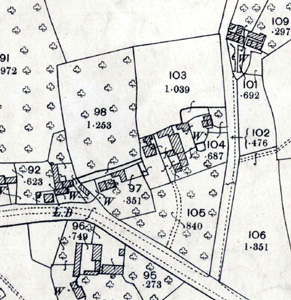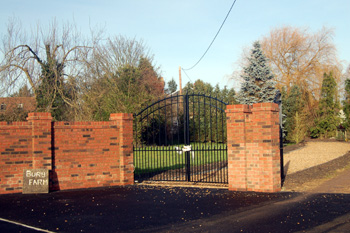
The area of Bury Farmhouse in 1901
On 22nd February 1865 Thomas Twidell died and left Bury Farm to Christopher Buckmaster as trustee. Buckmaster conveyed the farm to George William Olney for £2,500 on 30th September 1884 following an auction sale. In the same deed Olney then conveyed the farm to Gustavus Gadsden Jones for £20 profit [CCE2722/1]. At that date the farm contained three cottages and land amounting to 46 acres 1 roods, 26 perches, farmed by James Eames. On Jones' death, in 1902, he left the farm, then 52 acres, to his nephew William Labrum [CCE2722/1].
It is not widely remembered today but in 1917 Britain was facing starvation. The unrestricted German U-Boat campaign was destroying large numbers of ships carrying food across the Atlantic. As something of a panic measure it was decided to plough up old grassland in an effort to plant more arable crops to feed the country. County War Agricultural Executive Committees were given the task of finding suitable land. Usually the farmer objected, for the good reason that he knew that any crop obtained would be poor and/or uneconomic. David Eames at Bury Farm was ordered to plough up some of his grassland [WW1/AC/OP1/2] and duly objected for just these reasons. Eventually, the convoy system was introduced and matters eased enough to obviate the need to plough up meadow and pasture.
The Rating and Valuation Act 1925 ordered every piece of land and building in the country to be assessed to determine the rates to be paid on it. Stanbridge was assessed in 1927 and the valuer visiting Bury Farm [DV1/H28/42] noted that it was owned by William Labrum and occupied by David Eames, who had paid £170 per annum rent since 1916 for 52 acres [here the valuer has written, presumably because he considered the rent on the high side, "Oh!"].
The farmhouse ["Good house"] was built of brick and slate and comprised two reception rooms, a kitchen and dairy with five bedrooms above. Outside were a wood shed, workshop and coal shed. The homestead comprised: a weather boarded and corrugated iron five bay open feeding hovel; a barn; a cow house for three beasts; a loose box; two weather boarded and corrugated iron loose boxes; a harness place; two hen houses; a trap house for two and, at the rear, two loose boxes. In the meadow was a weather boarded and corrugated iron hen house.

Entrance to Bury Farm December 2008
William Labrum, then living at Sandstones, Heath Road, Leighton Buzzard, died in August 1949 and left the farm to three trustees for sale [CCE/2722/1]. In 1950 a small area of land was sold to Bedfordshire County Council as the site of a police house, and was exchanged the following year for a similar sized plot immediately to the east [POE197]. The farm was still vested in trustees when 2,932 square yards was sold to Bedfordshire County Council for road improvements in 1972 [CCE2722/6], when the farm was tenanted by Jack and Jennifer Kay Gotzheim [CCE2722/7]. In 1995 150 square metres conveyed in 1972 were conveyed by Bedfordshire County Council to the owner of the Red Lion in Tilsworth Road [CCE2722/9]